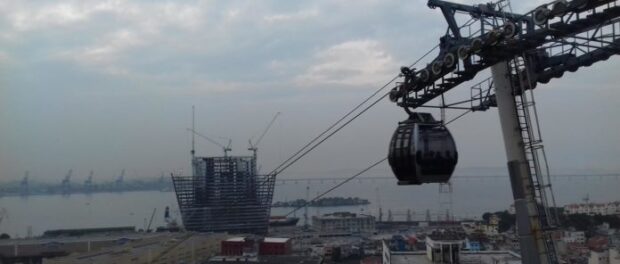
For the original article by Karine Ferreira in Portuguese published by Agência de Notícias da Favela click here.
Times are tough in Morro da Providência, the oldest favela in Brazil. Just like in Complexo do Alemão, Providência residents and workers who used the cable car, in this case to cross the João Ricardo Tunnel, are once again hindered by service interruptions.
Morro da Providência, located in downtown Rio, started to suffer from transport changes imposed back in 2013, while Eduardo Paes was Mayor of Rio. The Port Region began to get special attention from the City and businessmen, principally from the real estate industry. Even back in 2013 we were already starting to hear rumors of changes and construction works that would be carried out in the favela. Lots of houses were identified for removal (!), to make way for a funicular tram–a plan which ended up being shelved–which was to be built in one of the oldest areas of the favela: the steps of the Américo Brum Square. The square, regarded as the heart of the favela, later suffered a major change with the construction of a cable car station, which was installed with the promise that it would help increase residents’ mobility, though not everyone in the favela agreed. Despite many protests, construction took place without any consultation with residents who would be the most affected by the cable car.
Once the construction was completed, the cable car only partially functioned from 2014. This meant that residents that had already gotten used to the new means of transport ended up being inconvenienced by abrupt system closures. Since its inauguration with full opening times in 2015, the cable car has stopped functioning for “maintenance” at least three times, each time for an undetermined amount of time. Residents find out about closures through word of mouth in the favela, since there’s no official communication regarding service interruption, not even to inform residents when the car will be back in action.
Since the first week of December 2016, the Providência cable car has yet again been closed. The excuse is the same as the one given for the cable car in Complexo do Alemão: maintenance works. The same deadline is given: indefinite. This means that residents take one look at the closed doors of the cable car stations and go back to using alternative means of transport, or climbing the steep slopes to get to and from their houses.
The construction of the Providência cable car cost approximately R$75 million in public money. The result of the project is negligence which ended up turning the cable car into a white elephant. So much money wasted, local history buried by construction works, residents’ energies worn down… Was all this in vain?
There’s no doubt about who lost out the most with this project: the residents of Morro da Providência. The authorities are silent on the matter, and so is the mainstream media. Nobody knows, nobody saw anything, nobody has any answers to all the many people affected by this transport. Now we’re in 2017; this year the favela celebrates its 120th birthday. How long will favela residents have to live with the failure of the authorities?
